Waste Management
In this session, you’ll learn about the different categories of waste and the process for waste management.
Learning Objectives
By the end of this session, you will be able to:
- Identify the categories and sources of waste at the healthcare facility.
- Describe the best practices for minimizing, segregating, collecting, transporting, and storing healthcare waste.
- Identify the recommended treatment and final disposal methods for healthcare waste.
Learning Activities
-
Overview (5 min)
About 85% of the total amount of waste generated by healthcare activities is general, non-hazardous waste, according to WHO. The remaining 15% is considered hazardous material that could be infectious, toxic or radioactive. Hazardous waste that is not managed properly presents a risk to hospital patients, healthcare personnel, and the general public.
Healthcare waste includes all waste generated by health, research, and laboratory facilities in the course of providing healthcare services. Healthcare waste in a facility should be managed from point of generation to final disposal and removal. Improper handling of healthcare waste can endanger staff, patients, and the community. Hazards include exposure to infectious agents, toxic chemicals and radioactivity, and injury from sharp objects.
-
Categories & Sources of Waste (5 min)
Healthcare waste is divided into two main categories: hazardous and non-hazardous. If waste is not segregated correctly, hazardous waste can contaminate non-hazardous waste. This can make collection, transport, treatment, and disposal of waste difficult and hazardous. Also, treating non-hazardous waste as though it is hazardous results in wasted resources and effort.
Hazardous
Hazardous waste can harm people and the environment. It comes in three categories: infectious, toxic, and radioactive. The types of hazardous waste in a facility vary according to the size of the facility and the services offered. Click or tap on each type to read more about it.
Infectious waste
- Sharps waste is used or unused sharp items that could cause cuts or puncture wounds that can lead to infection. Examples include:
- instruments (such as scalpels and blades)
- needles
- syringes
- broken glass or ampoules
- Pathological waste (anatomical waste)
- human tissues or fluids (such as blood and body fluids)
- organs (body parts)
- placentas and fetuses
- unused blood products
- Other infectious waste
- soiled gloves
- gauze or bandages that are contaminated with blood, body fluids, viruses, or parasites
Toxic waste
- Pharmaceutical waste is used, expired, or no longer needed pharmaceutical products (such as vaccines and drugs)
- Chemical waste
- chemical substances (such as laboratory reagents or film developer)
- disinfectants
- solvents
- waste with high heavy-metal content (such as batteries, broken thermometers, and blood pressure gauges)
- Genotoxic (harmful to human genes) and cytotoxic (harmful to human cells) waste isn’t common unless the facility treats cancer patients. It includes:
- drugs used in cancer treatment
- body fluids from patients exposed to chemotherapy or cytotoxic drugs
- other material contaminated by these agents
Radioactive waste
- radioactive substances (such as unused liquids from radiotherapy or laboratory research)
- glassware, packages, or absorbent paper contaminated with radioactive substance
- urine and excreta from patients treated or tested with radionuclides
- sealed sources (containers in which radioactive substances are stored and sealed)
Non-hazardous
Non-hazardous waste does not pose biological, chemical, radioactive, or physical risk to people or the environment, and can be disposed of as municipal waste. Examples include paper, boxes, bottles, plastic containers, and personal protective equipment (PPE) that have not been contaminated with bodily fluids or used in an isolation area.
Municipal waste is general waste generated mainly by households and commercial activities, and ideally collected by municipalities (e.g., local villages or cities) for disposal. Municipal waste should not contain untreated medical waste. - Sharps waste is used or unused sharp items that could cause cuts or puncture wounds that can lead to infection. Examples include:
-
Types of Waste (5 min)
-
Waste Processing & Minimization (5 min)
Let us take a look at the waste management process recommended by the U.S. Centers for Disease Control and Prevention (CDC).

These next several learning activities will cover the steps in the waste management process in more detail. We will start by looking at how to minimize waste.
Minimizing Waste
Where feasible, minimizing the amount of waste that is produced by a healthcare facility is a good waste management practice. Waste minimization is most commonly applied at the point of generation, but it can also happen before items even enter the healthcare facility. Some examples of good waste minimization practice include:
- Select materials with minimal packaging.
- Choosing equipment that can be reprocessed locally—that is, appropriately cleaned, disinfected, and/or sterilized for reuse.
- Changing (or substituting) products. For example, using steam sterilization in place of a toxic chemical disinfectant (i.e., glutaraldehyde).
-
Segregating Waste (5 min)
Waste segregation can substantially reduce the quantity of healthcare waste that requires specialized treatment. Healthcare facilities should segregate waste when and where it is generated, such as before leaving a patient’s room, examination room, operating theatre, or laboratory. Staff should discard waste in the appropriate containers, based on the potential hazard of the waste and the treatment and final disposal methods. This step prevents staff from having to handle and separate waste later by hand—which is dangerous and should never be done.
Segregate waste by employing, at a minimum, a three-bin system. Use clearly labelled waste containers. Click or tap on each type of waste to read about WHO’s recommended segregation scheme.
General waste
Put general healthcare waste, such as food scraps and office waste, in a container lined with a plain plastic bag. Do not put this kind of waste in containers or bags with biohazard symbols on them. Look at this ward’s color-coded waste segregation system.
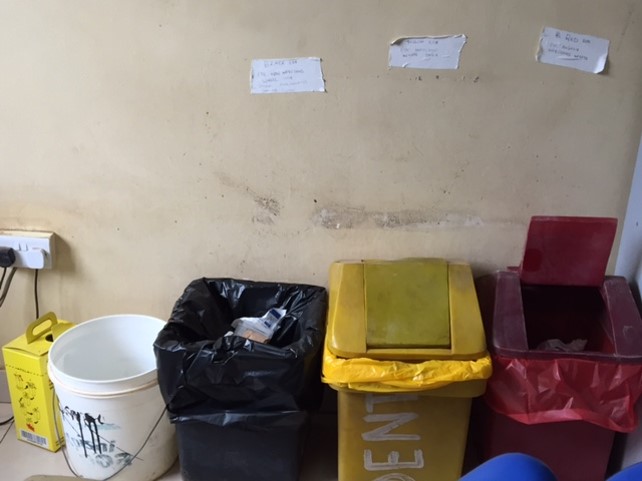
Hazardous sharps waste
Dispose of hazardous sharps waste, such as syringes, scalpels, suture needles, and glass, in a puncture-resistant sharps container to prevent needlesticks, cuts, and puncture injuries. Sharps containers should be labelled with a biohazard symbol and designated “sharps.” Sharps containers should be located within arm’s reach of where sharps are used. Avoid overfilling sharps containers—seal and discard them when they’re three-quarters full to prevent needlestick injury. Sharps containers should be single-use; never empty a container and then reuse it.
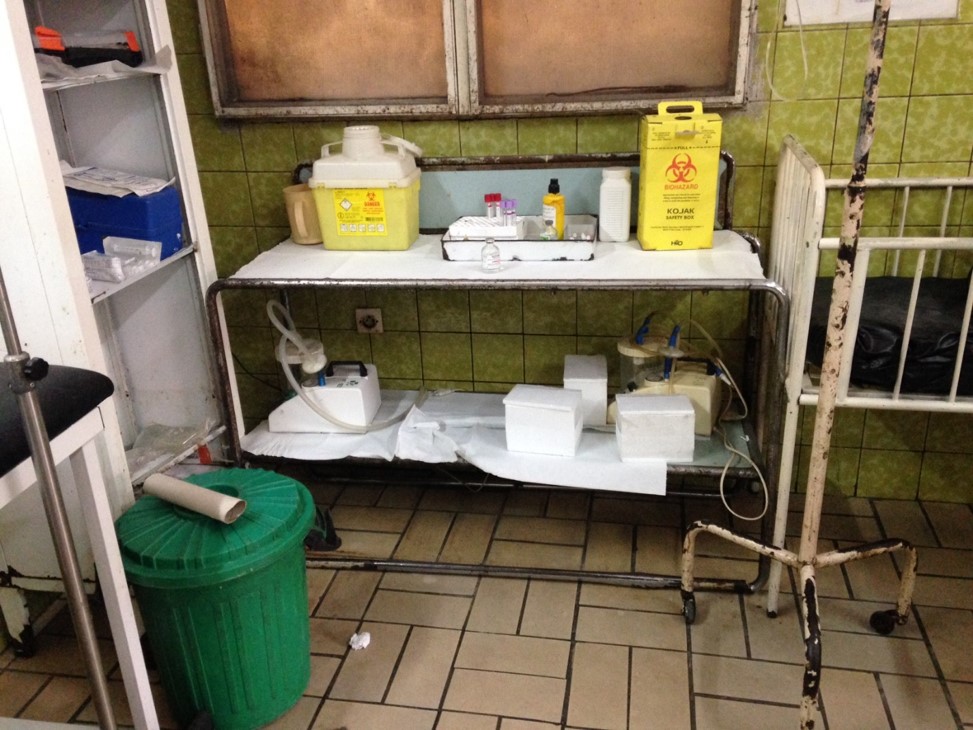
There are two appropriate sharps containers in this photo—one on the left side of the table and one on the right; in this case they happen to be yellow. The sharps bin on the left has a hard plastic top with a sealable lid. The sharps bin on the right looks a bit different—it is made of cardboard, and sharps are inserted through a hole in the top. Both serve the same purpose. Note that they are located at the point of care, close to the patient’s bedside, for safe and easy disposal.
If procurement of official sharps containers is difficult, you can provide low-cost options. Make improvised sharps containers from metal containers, plastic bottles, or durable cardboard boxes. Label them as “sharps waste.” Make sure you can completely close and tightly seal this container when it is three-quarters full to prevent it from being opened before final disposal.
Note: There are advantages and disadvantages to different types of sharps boxes. Cardboard is easier to burn and cheaper to procure, but might be less suitable in humid conditions. Rigid plastic boxes are sturdier and are designed to remain closed once the lid is secured.
Hazardous non-sharps waste
Other hazardous waste, such as pathological and pharmaceutical waste, should go in a container that is:
- Leak proof and puncture-resistant
- Covered with a lid
- Appropriately labelled and color-coded
- Lined with a plastic bag that is closed and discarded when three-quarters full to enable bag closure and safe transport
Look at this example of waste segregation. It is easy to see that the red bin is labelled as infectious waste. The blue bin for non-infectious waste should be larger, since 85% of waste is non-infectious.

Key Point: In your facility, the color of the container might be different than the color coding described here. What is crucial is that the container is labelled with the type of waste and that healthcare personnel know which types of waste go in which container.
-
Segregating Waste (5 min)
-
Collecting, Transporting & Storing Waste (5 min)
After waste is segregated, designate staff for each ward or unit to collect and transport it for disposal or transport it to a dedicated storage area to await disposal. We will now look at the collection, transportation, and storage steps in the waste management process.
Collection
When handling hazardous or infectious waste, always wear PPE. PPE should include:
- Utility gloves (not nitrile gloves)
- A heavy-duty apron
- Boots or closed-toed shoes
- Eye protection and/or face mask (if any splashes or sprays are anticipated)
Remember to remove PPE and perform hand hygiene after handling waste.
As with segregating waste, it is important to collect waste according to type. Collect general and infectious waste on a daily basis or more frequently—when the bag or container is three-quarters full. Consult national guidelines for how to dispose of chemical and pharmaceutical waste.
If you are collecting bags, tie them securely closed. Do not shake or squeeze bags to create more space in the bag when sealing them. Carry sealed bags at the top—that is, by the neck—and away from your body. Lifting or holding bags by the bottom or sides could cause injury (such as by sharp objects piercing through the bag), especially if they contain waste that was incorrectly discarded. Be sure that the bags are not broken, opened, dropped, or thrown.
Transportation
Equipment in the healthcare facility that holds and transports waste should not be used for any other purpose. If available, use separate equipment, such as a trolley or a wheelbarrow, to transport hazardous and non-hazardous waste separately. Dedicated equipment should be:
- Easy to load and unload
- Not have sharp edges that might tear bags or damage containers
- Easy to clean
- Clearly labelled
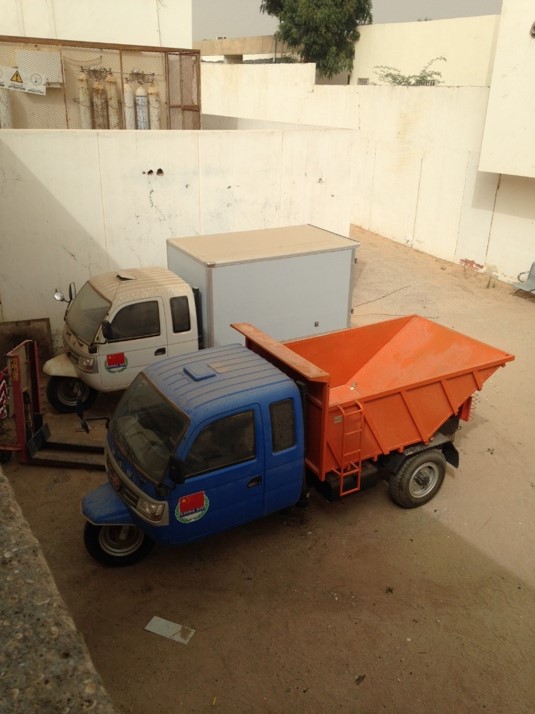
Storage
Store waste until it can be either treated or transported offsite. Healthcare facilities should have an operating plan for waste so that the need to store waste is minimized. When creating an operating plan, consider the volume of waste produced daily, waste management staffing needs, the size of storage areas, and final disposal method.
Waste storage areas can be located within the healthcare facility or in a designated area on the grounds. Whether kept indoors or outdoors, waste should be secured from people and animals, and protected from rain. Make sure the waste storage area is easily accessible by staff in charge of handling waste. If waste is transported offsite, consider placing the storage area where waste-collection vehicles have easy access. Waste storage areas should be of appropriate size for the volume of waste generated by the healthcare facility. Waste should not be allowed to accumulate for more than one or two days.
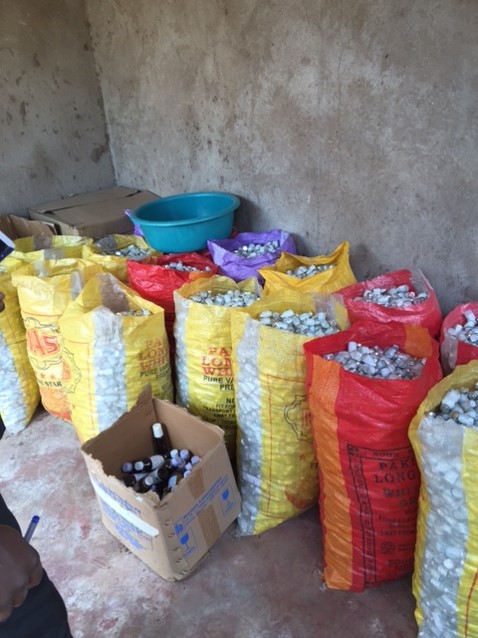
This picture represents a situation that should be avoided—there is a large volume of waste that has accumulated over time.
-
Treating & Disposing of Waste (10 min)
After collection, healthcare waste is treated and/or disposed of according to its type. WHO recommends treating hazardous waste before disposal to minimize risk and hazard. The disposal method depends on how it has been treated, as well as on the type and quantity of waste, available space on site, and access to offsite disposal options.
While general non-hazardous healthcare waste (municipal waste) can be disposed of without treatment, hazardous waste should be treated prior to final disposal. Healthcare facilities should conduct a risk assessment based on the type and quantity of waste and access to resources, and choose the methods that will pose the least risk to the community and the environment.
Click or tap on each treatment method to read more about it.
Thermal methods
Thermal methods, which destroy microorganisms in waste through heat, include low- and high-heat technologies.
- Non-combustion (low-heat) processes, like autoclaves and steam-based treatment systems, operate at 100–180 °C (212–356 °F). This is a picture of autoclaves, which use steam to decontaminate medical waste.
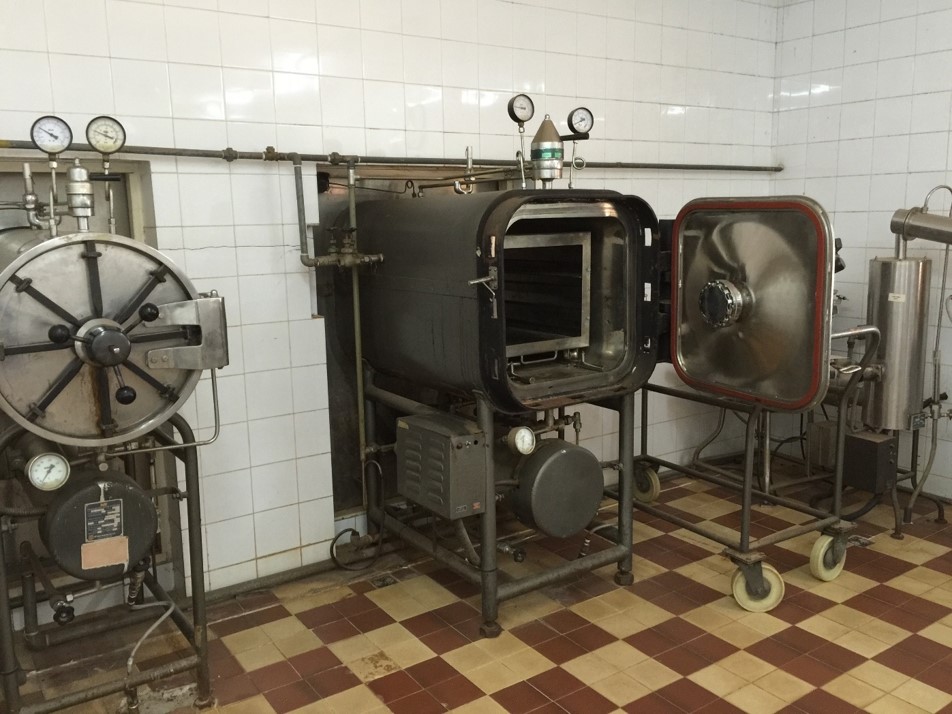
- Combustion (high-heat) processes operate at about 200 °C (392 °F) to more than 1,000 °C (1,800 °F). The most common example of this method is incineration.
Incinerators can range from extremely sophisticated, high-temperature models to very basic units that operate at much lower temperatures. All types of incinerators, if operated properly, eliminate microorganisms from waste and reduce the waste to ashes. Incinerators can be efficient and affordable. This is a picture of a functioning incinerator. Notice that no items are sitting outside of the incinerator and there is no accumulation of waste.
In accordance with the Stockholm Convention, use the best available technology to achieve recommended levels of dioxin and furan emissions.

For healthcare facilities with limited resources, and where high-temperature incinerators are not affordable or feasible, De Montfort brick (double-chamber) incinerators are often used. Double-chamber incinerators allow for higher temperatures, which incinerates waste more effectively and reduces toxic emissions. Drum (single-chamber) incinerators can also be used, but are not recommended. Low-temperature incinerators are considered a better option than open burning.
Avoid open burning of healthcare waste—it releases toxic gases and does not fully destroy infectious waste because it cannot reach high enough temperatures. However, it can be used in emergencies, such as outbreaks of communicable disease, until incinerators or other treatment methods (such as autoclaves) become available.
Chemical methods
With chemical methods, waste is exposed to a chemical agent that kills microorganisms, like chlorine dioxide, sodium hypochlorite, lime solution, or calcium oxide powder.
Irradiation methods
Irradiation methods use ultraviolet radiation or microwaves to destroy microorganisms. They supplement other disposal methods and are not easily accessible in low- and middle-income countries.
Biological methods
Biological methods, which include composting and burial, rely on the natural decomposition of organic matter. These processes are recommended for placentas.
Mechanical methods
Mechanical methods include shredding, grinding, mixing, and compacting technologies that reduce waste volumes but do not destroy microorganisms; they usually supplement other treatment methods. These processes can be used to destroy needles and syringes. Use them only after the waste has been disinfected, or as part of a closed system.
If the treatment methods listed above are not available, small quantities of waste can be buried onsite for the short term, in an appropriately constructed burn pit, while treatment options are being identified.
Infectious Waste Treatment and Disposal
Specific types of infectious, non-sharps waste require different methods for treatment and disposal.
Pathological/anatomical waste: Waste in these categories is traditionally buried or cremated in incinerators. Treatment and disposal of pathological and anatomical waste might be bound by sociocultural and religious norms. For example, placenta waste can be buried in pits or taken home.
Liquid infectious waste: This type of waste includes liquid culture media, blood, body fluids, human excreta, and rinsing liquids from operating theatres. Autoclaves and incineration technologies typically available in low-resource settings are not effective for large quantities of liquids. Liquid infectious waste can be disposed of directly into a closed sewer system (such as a utility sink drain or flushable toilet) or onsite septic tank system by staff wearing PPE and taking precautions to avoid splashing. If neither is available, this waste should be poured directly into a pit latrine. Disposing of liquid infectious waste into pipes that go to open drainage canals should not be conducted without pre-treatment.
If you use the sink or toilet for disposal of liquid infectious waste, be sure to thoroughly rinse with water and clean and disinfect the sink or toilet using 0.5% chlorine solution to remove residual waste.
Other Hazardous Waste Treatment and Disposal
Chemical, pharmaceutical, and radioactive waste should be included in the national strategy for hazardous waste, and should be treated in accordance with international and local regulations.
Ash from incineration is considered to be hazardous because it can contain heavy metals and other toxic materials. Ash should be disposed of properly at hazardous waste sites (such as engineered landfills), encapsulated and buried, or disposed of in a concrete-lined ash pit. Avoid direct contact and inhalation, and wear appropriate PPE (such as utility gloves, plastic apron, goggles, and mask or N95 respirator).
Other Treatment and Disposal Options
If healthcare facilities do not have the ability to treat waste or return it to the manufacturer, encapsulation or inertization can be used to dispose of small quantities of sharps, chemicals, or pharmaceutical waste. These methods can reduce the risk of injury to people and minimize the risk of toxic substances migrating into surface or groundwater. These methods are rarely used.
- Encapsulation is a process that seals waste containers with an immobilizing material, such as cement. After hardening, the containers can be safely disposed of in a landfill.
- Inertization involves mixing of waste (such as pharmaceutical and high-metal-content ash) with water, lime, and cement before disposal to reduce the risk of toxic substances leaching into surface and groundwater. Pharmaceuticals must be removed from their packaging and ground before being mixed.
This table shows the different methods for treating and disposing of infectious waste.
Treatment Disposal Sharps Waste Autoclave followed by shredding Landfill or sharps pit Incineration (sharp objects may not be completely destroyed by incineration, but it does make them less likely to be reused or repurposed and less risky to handle) Sharps pit Infectious, non-sharps waste Autoclave Landfill Autoclave followed by shredding Encapsulation Incineration Ash pit - Non-combustion (low-heat) processes, like autoclaves and steam-based treatment systems, operate at 100–180 °C (212–356 °F). This is a picture of autoclaves, which use steam to decontaminate medical waste.
-
Disposal Sites (5 min)
In the previous section, we mentioned various types of disposal sites. We will now learn about these sites in more detail. Click or tap on each category to read more about it.
Landfills
If done properly, the disposal of healthcare waste—both treated and untreated—in landfills can protect staff, the community, and the environment. Landfills are specifically designed and engineered for the safe disposal of waste on land. Properly built landfills:
- Restrict access to prevent scavenging
- Prevent infiltration by water
- Are lined with a low-permeability material (such as clay)
Ideally, by the end of each working day waste should be spread in thin layers, compacted and covered with soil. Gases should not be allowed to accumulate to the extent they become hazardous.
Placenta pit
In many cultures, burying placentas is an important custom. In low-resource settings, a placenta pit is an effective option for safe disposal. The site for a placenta pit should minimize public accessibility; the size will depend upon the number of daily childbirths at the facility. On average, one placenta and its associated fluids will require 5 litres (1.5 gallons) of pit capacity. Natural degradation and the draining of liquid into the subsoil greatly reduces the volume of waste in the pit and facilitates the inactivation of pathogens. Small quantities of anatomical waste (body parts) can also be disposed of in placenta pits if other treatment options are not available, or if sociocultural or religious norms prohibit other forms of treatment.
The pit should be designed to prevent waste from contaminating the surrounding groundwater. A distance of at least 1.5 metres (approximately 5 feet) from the bottom of the pit to the groundwater level is recommended. Placenta pits are not recommended for sites where the water table is near the surface, or in areas prone to flooding.
Sharps pits
Even after decontamination, sharps waste could still pose physical risks. There could also be risk of reuse. Decontaminated sharps waste can be disposed of in concrete-lined sharps pits on facility premises or encapsulated by mixing waste with immobilizing material, such as cement, before disposal. These procedures are recommended only in cases where the waste is handled manually and the landfill for general waste is not secured.
Small burial sites for waste disposal
At healthcare facilities with limited resources, short-term, safe burial of waste on or near the facility might be the only option available for waste disposal. Safe onsite burial is practical for only limited periods of time (1–2 years) and for relatively small quantities of waste. Burial can be used as a method of waste disposal only where the water table is more than 4 metres (12 feet) below the surface. During this time, the healthcare facility should continue to look for better, more permanent methods for waste disposal.
-
Quiz (5 min)
-
References
- Chartier Y, Emmanuel J, Pieper U, Prüss A, Rushbrook P, Stringer R, et al, editors. Safe management of wastes from health-care activities, 2nd ed. Geneva: World Health Organization (WHO); 2014.
- International Committee of the Red Cross (ICRC). Medical waste management. Geneva: ICRC; 2011.
- Training module 15: Non-incineration treatment and disposal. New York/Washington (DC): United Nations Development Programme (UNDP) Global Environment Facility (GEF).
- United Nations Environmental Programme (UNEP), Secretariat of the Basel Convention. Technical guidelines on the environmentally sound management of biomedical and health care waste (Y1; Y3). Châtelaine, Switzerland: UNEP, Secretariat of the Basel Convention; 2003.
- UNEP. Toolkit for identification and quantification of releases of dioxins, furans and other unintentional pops under Article 5 of the Stockholm Convention on Persistent Organic Pollutants. Geneva: UNEP; 2013.
- University of North Carolina (UNC). Laboratory safety manual: hazardous waste containers. Chapel Hill (NC): Finance and Operations—Environment, Health and Safety, UNC; 2017.
- USAID | DELIVER PROJECT, Task Order 4. Guide to health care waste management for the community health worker. Arlington (VA): USAID | DELIVER PROJECT, Task Order 4; 2011.
- World Health Organization (WHO). Safe management of wastes from health-care activities: a summary. Geneva: WHO; 2017 (WHO/FWC/WSH/17.05) Licence: CC BY-NC-SA 3.0 IGO.
